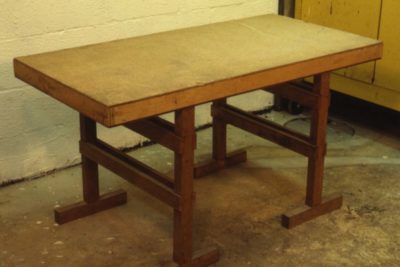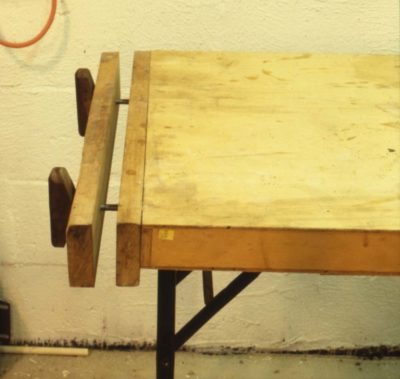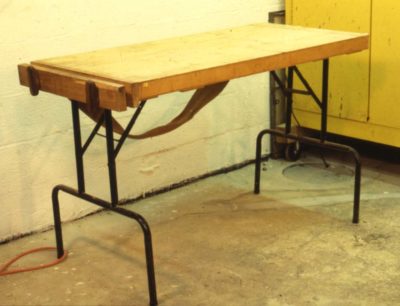Workbench Wednesday — Bench #2 , 1990, Prototype(s)
Because of the rigidity and (light)weight requirements for the portable restoration workbench, the obvious choice for the top was a torsion box, the construction of which was virtually identical to those described in the woodworking literature. My first attempt used 1/4″ faces and 1/2″ ribs of luan plywood. The weight and rigidity were good, but the working surface of luan was a little too fragile. Nevertheless it was a confirmational “proof of concept” exercise.

My first step was to make a simple torsion box as a test run. It was near-perfect as the top and working surface. I faced this prototype with cork on one side and plastic laminate on the other, and it remains in use in the shop to this day almost thirty years after being made.
Concept One – check.

My first inclination was to make a trestle base for the bench, but considering my master scheme this idea had some significant drawbacks. While easy to build and assemble, the knock-down/assemble/disassemble trestle requires multiple parts, and one of my stated intentions was to not build anything that required keeping track of lots of pieces. Instead, on my first attempt I tried using a pair of commercially available tubular-steel folding-table legs. These worked fine along the short axis of the bench but weren’t stiff enough along the long axis because of short diagonal braces. Though a good concept, this shortcoming and the unnecessary weight of the steel legs made it a non-starter as a final option. Even with those hefty legs the unit weighed in at only 55 pounds, well within the limit I wanted.
Concept Two – check.

As for the vises I simply used pieces of 2x stock cut to match the dimensions of the ends of the top combined with 3/8″ steel threadstock from the hardware store and some wood handles epoxied onto the ends. Again the concept was successful but the fine-ness of the thread made the vises tedious to use.
Concept Three – check.
Finally I threw on a piece of upholstery webbing to serve as a shoulder strap so the folded bench could be carried and maneuvered easily. That concept was an absolute winner. Throwing the strap over my shoulder it was a breeze to navigate the twisting rabbit trail to a work site.

As a final test run I took the prototype to a job and it worked out just fine within the confines of the limitations enumerated above. With what I learned from this it was time to move forward with a final iteration.
Check, check, check, and check.
By the way, this bench is still in use but as a food preparation station for the barbecue.


Join the Conversation!